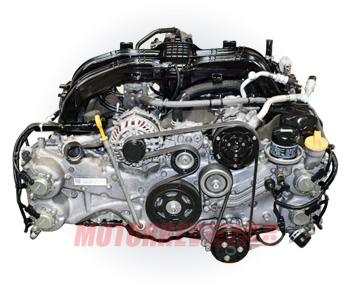Subaru FB25D 2.5L Engine Specs, Problems, Reliability, Info

Subaru FB25D Overview
In 2018, the FB series was extended with a new 2.5-liter flat-four engine, called the FB25D or FB25 DI. This naturally aspirated, four-cylinder, boxer engine was first introduced at the 2018 New York International Auto Show, as a new power option for the 2019 Subaru Forester model year. Later, the FB25D was made available for other popular Subaru models, such as the Subaru Legacy, Outback, and Crosstrek. Let's take a look at the changes made compared to its predecessor, FB25B.
FB25D Engine Design
As can be understood from the name of the engine, it was not created from scratch. This is a further development of the FB25 engine. The new version is still based on an open-deck style aluminum cylinder block, but it has modified 8-valves (4 valves per cylinder) aluminum DOHC heads with chain-driven camshafts. As before, there are no hydraulic lifters found in the valve train. Intake and exhaust camshafts have a variable valve timing system installed, called dual AVCS. Valve covers are now made of plastic, not aluminum.
The main difference between the previous FB25 and this one is the direct fuel injection system. This is indicated by the letter "D" at the end of the model name. The FB25D engine has a high-pressure fuel system, which includes a high-pressure fuel pump (in addition to regular fuel pump inside the fuel tank), a high-fuel rail, and direct injectors in heads that inject gasoline directly into the combustion chambers. Of course, the injection process is controlled by the ECU. The direct injection system works in combination with a high-energy coil-on-plug electronically controlled ignition system. The intake manifold is also different. As before, it is made of plastic, but the shape of the channels has been optimized.
Subaru has replaced the traditional mechanical thermostat with a Thermo Control Valve (TCV) to control the cooling system. The TCV is located on the top of the FB25D engine, specifically on the coolant crossover pipe, beneath the driver's side of the intake manifold. The FB25D also has a water-cooled exhaust gas recirculation (EGR) system and it features a very high compression ratio of 12:1.
What's the End Result?
The new engine turned out to be slightly heavier than its predecessor (11 lbs or 5 kg more), but it produces 7% more power and a bit more torque within the same RPM range. At the same time, it consumes less fuel and has better MPG and emissions (meets Euro-6). By now, Subaru has fully transitioned to using this new engine, and the production of the FB25B engine has been discontinued.
Engine Specs
180 hp (130 kW)/5800
178 lb-ft (241 Nm)/ 3700
Oil recommendations and capacity may vary depending on the car model, year, and market. Please check the service manual specific to your vehicle!
FB25D Problems and Reliability
The FB25D engine has been introduced not so long ago, but some issues have already started to pop up.
- In the beginning, the TCV caused many problems. In May/June 2021, Subaru made some design changes and extended the warranty for this part/repair to 15 years and 150,000 mileage.
- The engine does not have hydraulic lifters, so you may need to adjust the valves from time to time.
- Almost every engine with direct injection suffers from a carbon build-up problem. Carbon forms on the intake valves and ports, which leads to a deterioration in engine performance. Additionally, these engines are more sensitive to the quality of fuel.
- Owners of FB25 DI often complain about oil leaks.
Summary
If we compare FB25D with the previous 2.5-liter Subaru boxer engines, it has a more complex and therefore less reliable design. The limiting factors here are the not very strong engine block, direct injection, and electronic thermo control valve. The engine life is around 150,000-200,000 miles (250,000-300,000 km). To extend the life of this boxer engine, it is recommended to use premium gas, high-quality oil, and strictly follow a maintenance schedule.
